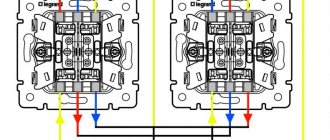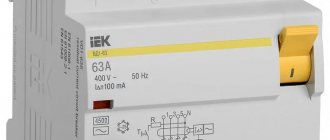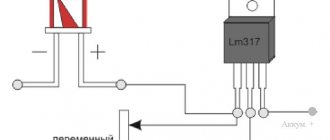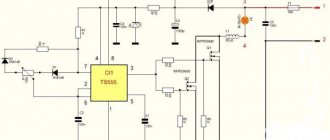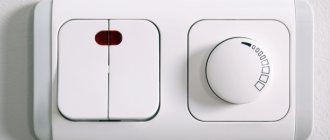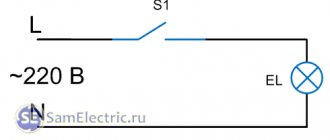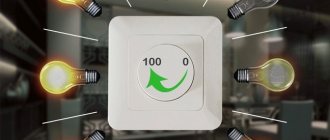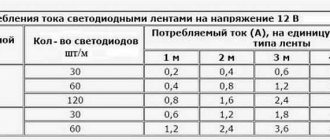Adjusting the brightness of lamps may be necessary to reduce the level of illumination or dim the light. Modern electronics allows you to do this by using the simplest and small-sized devices called dimmers. The dimmer switch, in addition to the usual function of turning lamps on/off, regulates the amount of voltage supplied to them, thus changing the brightness of the light.
Dimmer
In addition to reducing brightness, there is a significant reduction in energy consumption and extension of the service life of the light source. When an incandescent lamp (regular or halogen) is connected to the network, a current surge occurs, since a cold spiral has a low ohmic resistance, and until the spiral warms up, a large current flows through it. Although this time is a fraction of a second, the vast majority of lamp failures occur at the moment of switching on. An adjustable light switch allows you to reduce the initial surge of current through the lamp. Smooth heating of the filament leads to an increase in the service life of the lamps.
Dimmer purpose
The main purpose of such devices is to regulate the brightness of incandescent or halogen lamps. Halogen lamps that operate at reduced voltage are controlled using a dimmer connected through a step-down transformer. These devices can be purchased separately, but it is better to buy a dimmer with a built-in transformer.
Attention! To work in lighting circuits with LED and fluorescent lamps, it is necessary to use special dimmers.
To control energy-saving lamps, devices are used whose design includes an additional element - an electronic starter.
Using the brightness control as a light switch, you can arbitrarily change the lighting intensity from maximum to dimmest. In this case, there is no need to use double or triple switches to control the operation of chandeliers with several lamps. In addition, it makes no sense to purchase expensive lamps equipped with their own voltage regulators.
Recommendations for selection
To choose the right device, you should study the installation options:
- The standard connection option is to control the light from one point in the room.
- In bedrooms, you can install two devices - at the entrance to the room and near the bed, which allows you to change the intensity of lighting when going to bed.
- Let’s assume an option where light control is carried out from one place, and control is carried out from two. This could be a switch at the entrance and two regulators in different areas of the room.
- Option in the ratio “three control points and one control point.” Here you can use pass-through dimmers, when turning on lamps in one area of the room automatically turns off lighting devices in others.
Two dimmers and one switch
Control from two points
Control from one point
A variety of ways to connect a dimmer allows you to choose the best option for each room, taking into account the characteristics of its operation.
Dimmer classification
There are currently several types of monoblock dimmers on the market:
- Dimmers with a mechanical regulator, which is made in the form of a rotary disk. The design of such products is relatively simple, which explains their quite reasonable price. There are dimmers with push or turn switching. In the first case, to close the electrical circuit, you need to lightly press the control knob; devices of the second type always turn on the light, starting from its minimum intensity.
- Dimmers with push-button control. They are more complex devices, but their functions are significantly expanded due to the possibility of combining such regulators into groups, which can be controlled from the remote control.
- Touch dimmers. They are quite expensive, but also the most prestigious devices that fit perfectly into the interiors of rooms decorated in a modern style. In addition, touch-sensitive models, like dimmers of the previous type, are equipped with signal receivers that allow you to change the lighting intensity using an infrared remote control or via radio.
In addition to monoblock dimmers, there are devices with modular control, which is carried out using a remote button or a key switch. Such regulators are used to control lighting in public places, as well as for installation in distribution boxes.
As already mentioned, most dimmer models are designed for use in circuits with incandescent or LED lamps.
When choosing a dimmer, you need to pay special attention to its power, which must exceed the total maximum power of all consumers connected through this device. Today, in electrical goods stores you can find light controllers with a power of 40 W to 1 kW.
As for the design, there are single, double and triple dimmers on the market. Moreover, the vast majority are single models.
Methods of regulation
- Mechanical - turn the handle. First, the dimmer is turned on until it clicks, and then the brightness is set. The turn-and-press device is more convenient, since you can use a switch with constant adjustment of the regulator.
- Electronic: push-button, keyboard. Can be used as a switch and regulator.
- Touch - the control panel implements many different functions.
- Remote – control via radio signal or using an IR remote control.
Automatic dimmer for incandescent lamps
Design of switches with dimmer
The main element of the dimmer design is the electrical circuit, which is designed to reduce the effective value of the voltage supplying the load.
Ensuring reliable operation of this circuit is carried out using several types of protection, which include protection against short circuit, overvoltage and overheating.
Like a regular light switch, the dimmer has a metal frame that allows you to easily install it in a standard socket box.
Design
Cotton switch
Based on their design and application features, dimmable light switches are divided into two groups:
- Modular design;
- Designed for installation instead of conventional switches.
Modular switches are not intended for domestic use and are mounted in power switchboards. They usually dimm entrance lighting.
The most common design of modular devices has push-button dimming. A single press of the button turns the lighting on or off, and a long press (more than 5 seconds) allows you to enter the adjustment mode and set the desired output voltage level.
Some models have additional adjustment of the maximum and minimum voltage values.
Modular dimmer
Household adjustable switches have a wide variety of designs. For the most part, they are designed for installation in standard mounting boxes for conventional switches, so there is no need to resort to special installation measures.
Device diagram
The main element of the electrical circuit on which the dimmer switch is built is a bidirectional triode thyristor - a device that is an electronic switch controlled by a short pulse.
One of the most common brightness control circuits is shown in the figure.
The signal to open and close the thyristor is supplied using a capacitor of a certain capacity, which accumulates charge during the passage of the first half-wave of the supply voltage.
Principle of operation
Modern dimmers are not consumers of electrical power. This is their fundamental difference from earlier analogs that operated using an active or capacitive voltage divider circuit.
Previous generations of voltage regulators were either rheostats connected in series with the load or autotransformers. In both cases, the manufacture and use of such devices turned out to be extremely expensive. The use of a rheostat, in addition to significant financial costs, led to a significant increase in the weight of the light controller. In addition, when current flows through the rheostat, it becomes very hot, which leads to significant power losses and forces the need to consider the need to cool this device.
Unlike a rheostat, an autotransformer is not a consumer of energy, but it has an extremely large mass and dimensions.
It is possible to avoid power losses in the dimmer due to an electrical circuit that allows you to supply power to consumers by “cutting off” the front or rear part of the half-wave of the supply voltage. This operating principle is called phase control with cutting off the leading or trailing edge.
The operating principle of a dimmer that cuts off the leading edge of a half-wave of a voltage sine wave:
The figure shows the shape of the supply voltage in a circuit whose circuit contains a controlled thyristor, which is automatically turned on when the voltage reaches zero.
Depending on the operating mode, which is determined by the response time (from 0 to 9 ms), it is possible to achieve a smooth change in the power consumed by the lighting device.
Dimmer installation
The connection of a single brightness control is carried out according to the same scheme as the installation of an ordinary key switch. Thus, when installing a dimmer instead of an existing switch, there is no need to make any changes to the electrical wiring design.
The connection diagram, as well as the dimensions of the socket box and the marking of the terminals are absolutely identical.
Some difficulties may arise only if the light dimmers are connected as pass-through switches or combined into groups controlled by a remote control. A diagram of their connection of three outputs for connecting electrical wires.
Connecting the dimmer
There are several dimmer connection schemes.
Dimmer circuit with switch
In the described case, the dimmer is installed in front of the dimmer in a phase gap. The switch controls the flow of current. The connection diagram is shown in the figure below.
From the switch, the current is directed to the dimmer, and from there to the incandescent light bulb. As a result, the regulator determines the desired brightness level, and the switch is responsible for turning the chain on and off.
The scheme is well suited for bedrooms. The switch is placed near the door, and the dimmer is located near the bed. This makes it possible to control the light directly from the bed. When a person leaves the room, the light goes out, and when a person returns to the room, the light lights up with the characteristics that were set by the dimmer.
Connection diagram with two dimmers
This circuit contains two soft light switches. They are mounted in two places in one room and are essentially pass-through switches that control individual lighting fixtures.
The circuit involves connecting three conductors to the junction box from each point. To connect dimmers, connect the first and second contacts in the dimmers with jumpers. Then the phase that goes to the lighting device through the third contact of the second dimmer is supplied to the third contact of the first dimmer.
Circuit with two pass-through switches
This scheme is used quite rarely. It is in demand for organizing lighting control in walk-through rooms and long corridors. The circuit allows you to turn the light on and off, as well as adjust it from different ends of the room.
Pass-through switches are placed in a phase gap. The contacts are connected by conductors. The dimmer enters the chain in a sequential manner, after one of the switches. A phase approaches the first contact, which then goes to the incandescent lamp.
Brightness control is carried out by a dimmer. However, it should be borne in mind that when the regulator is turned off, the pass-through switches are not capable of switching light bulbs.
Advantages and disadvantages of using dimmers
Advantages:
- The ability to arbitrarily change the brightness of light in a room not only greatly increases the ease of use of the lamps, but also provides wide scope for interesting design solutions.
- Reducing the voltage at the consumer without dissipating power allows for significant energy savings.
- When operating at reduced voltage, the life of the lamps is significantly extended.
- Using a dimmer can to some extent protect the consumer from voltage surges, which are one of the main reasons for the failure of incandescent lamps.
- The lamps are turned on at the moment the supply voltage sinusoid passes through zero, which prevents a sharp increase in the current in them.
Flaws:
- The relatively high price of these dimmers compared to conventional key switches.
- If it is necessary to replace a double or triple switch with a dimmer, significant difficulties arise associated with the purchase of an expensive double dimmer model or equipment of additional points for installing two or three such devices.
- Distortion of the supply voltage curve. This drawback does not greatly affect the performance of active energy consumers such as incandescent lamps. At the same time, the use of dimmers can have an extremely negative impact on the operation of electronic consumers.
Thus, the use of dimmers as lighting regulators is completely justified in cases where a smooth change in the brightness of the light is really necessary. At the same time, due to the high cost of these devices, using them instead of all switches in the apartment seems impractical.
Precautionary measures
Lighting with regulators with mechanical switching does not require special precautions other than generally accepted ones, since when the regulator is in the off position, the circuit is completely opened by a mechanical switch. In electronic devices, the circuit is completely switched by a triac, there is no mechanical disconnection, and there is a galvanic connection between the terminals of the triac. If there is a defect in the control element, it is possible that there is some potential present at the terminals of the lamp socket. Working in networks with electronic regulators requires a complete shutdown of the supply voltage at the distribution board.
A dimmable light source not only improves comfort, but also serves as a means to reduce energy and lamp replacement costs. In general, installation of adjustable switches can be done by an untrained user, but in some cases experience is required. Before connecting a lighting controller, you need to weigh your options, and it is better to use the services of a professional electrician.

